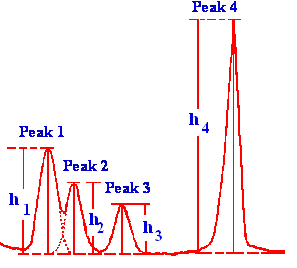Measurement Methods from Thin Layer Chromatography
Thin Layer Chromatography
by Raymond P. W. Scott,
part of the Chrom-Ed Series
In addition, the noise level is much smaller and, thus, the measurements are more sensitive (the detection limit can be one to two orders of magnitude smaller than that obtained from transmittance or reflectance measurements). As a consequence, the measurements will also have a wider dynamic range. It is usually necessary to insert a cut-off filter (of the appropriate wavelength) between the plate and the fluorescence sensor to remove all scattered excitation light. The presence of scattered excitation light provides a background signal that can significantly increase the noise and, thus, reduce both the sensitivity and the linear dynamic range of the quantitative measurement.
Measurement Methods
There are two common methods assessing the spot composition from a scanned chromatogram; the two methods are by peak height and peak area measurements (including sliced area measurements); the measurement of peak heights is depicted in figure 23.

Figure 23. Peak Height Measurements on a TLC Plate
The advantages of peak height measurement over peak area measurement are that the possibilities of error by peak overlap are much reduced if height measurements are employed. It follows that quantitative accuracy is not seriously compromised if the peaks are not completely resolved. Examples of two types of peak integration are shown in figure 24. In the case of peak area measurement it is clear that for accurate total area integration, adequate resolution must be achieved otherwise there can be significant errors that will result due to peak overlapping. Unfortunately, complete resolution is often far more difficult to achieve in thin layer chromatography than in other forms of chromatography and, consequently, a modified form of peak integration, called sliced area integration, is sometimes used.
